Cultural Health Care: Providing Care in Diverse Cultural Settings
VerifiedAdded on 2023/06/08
|10
|2821
|159
Essay
AI Summary
This essay examines the importance of cultural sensitivity and competence in healthcare settings, focusing on the unique needs of patients from diverse cultural backgrounds. It discusses the impact of cultural beliefs on healthcare practices and decision-making, highlighting the significance of respecting patients' values, traditions, and preferences. The essay provides specific examples of how to provide culturally appropriate care for Aboriginal, Muslim, Japanese, and Sudanese patients, emphasizing the need for healthcare providers to be aware of communication styles, dietary restrictions, religious practices, and family dynamics. It underscores the importance of building trust with patients by demonstrating cultural awareness and sensitivity, ultimately improving the quality and acceptability of healthcare services in an increasingly diverse society. This resource can be found with other past papers and solved assignments on Desklib.
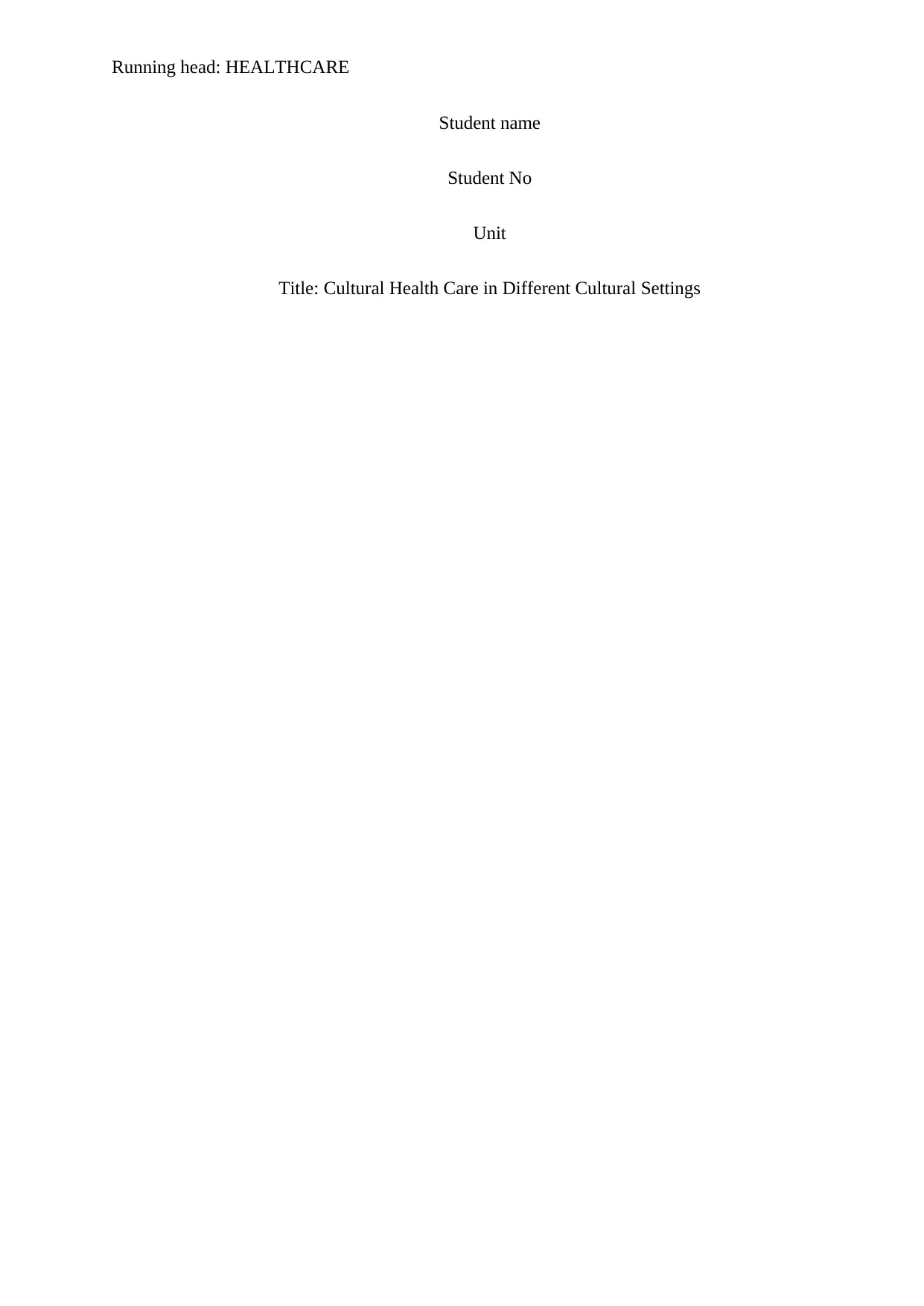
Running head: HEALTHCARE
Student name
Student No
Unit
Title: Cultural Health Care in Different Cultural Settings
Student name
Student No
Unit
Title: Cultural Health Care in Different Cultural Settings
Paraphrase This Document
Need a fresh take? Get an instant paraphrase of this document with our AI Paraphraser
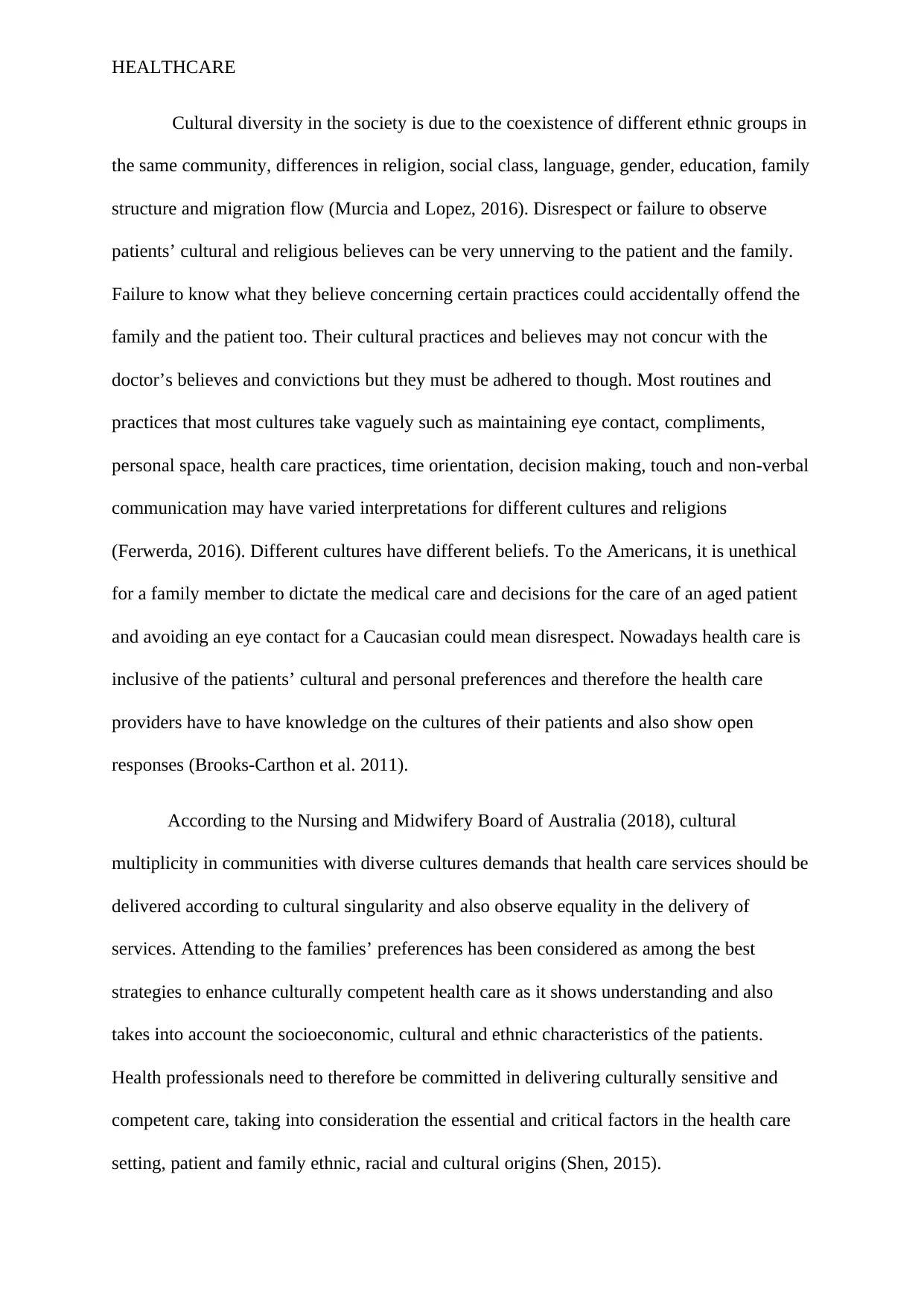
HEALTHCARE
Cultural diversity in the society is due to the coexistence of different ethnic groups in
the same community, differences in religion, social class, language, gender, education, family
structure and migration flow (Murcia and Lopez, 2016). Disrespect or failure to observe
patients’ cultural and religious believes can be very unnerving to the patient and the family.
Failure to know what they believe concerning certain practices could accidentally offend the
family and the patient too. Their cultural practices and believes may not concur with the
doctor’s believes and convictions but they must be adhered to though. Most routines and
practices that most cultures take vaguely such as maintaining eye contact, compliments,
personal space, health care practices, time orientation, decision making, touch and non-verbal
communication may have varied interpretations for different cultures and religions
(Ferwerda, 2016). Different cultures have different beliefs. To the Americans, it is unethical
for a family member to dictate the medical care and decisions for the care of an aged patient
and avoiding an eye contact for a Caucasian could mean disrespect. Nowadays health care is
inclusive of the patients’ cultural and personal preferences and therefore the health care
providers have to have knowledge on the cultures of their patients and also show open
responses (Brooks-Carthon et al. 2011).
According to the Nursing and Midwifery Board of Australia (2018), cultural
multiplicity in communities with diverse cultures demands that health care services should be
delivered according to cultural singularity and also observe equality in the delivery of
services. Attending to the families’ preferences has been considered as among the best
strategies to enhance culturally competent health care as it shows understanding and also
takes into account the socioeconomic, cultural and ethnic characteristics of the patients.
Health professionals need to therefore be committed in delivering culturally sensitive and
competent care, taking into consideration the essential and critical factors in the health care
setting, patient and family ethnic, racial and cultural origins (Shen, 2015).
Cultural diversity in the society is due to the coexistence of different ethnic groups in
the same community, differences in religion, social class, language, gender, education, family
structure and migration flow (Murcia and Lopez, 2016). Disrespect or failure to observe
patients’ cultural and religious believes can be very unnerving to the patient and the family.
Failure to know what they believe concerning certain practices could accidentally offend the
family and the patient too. Their cultural practices and believes may not concur with the
doctor’s believes and convictions but they must be adhered to though. Most routines and
practices that most cultures take vaguely such as maintaining eye contact, compliments,
personal space, health care practices, time orientation, decision making, touch and non-verbal
communication may have varied interpretations for different cultures and religions
(Ferwerda, 2016). Different cultures have different beliefs. To the Americans, it is unethical
for a family member to dictate the medical care and decisions for the care of an aged patient
and avoiding an eye contact for a Caucasian could mean disrespect. Nowadays health care is
inclusive of the patients’ cultural and personal preferences and therefore the health care
providers have to have knowledge on the cultures of their patients and also show open
responses (Brooks-Carthon et al. 2011).
According to the Nursing and Midwifery Board of Australia (2018), cultural
multiplicity in communities with diverse cultures demands that health care services should be
delivered according to cultural singularity and also observe equality in the delivery of
services. Attending to the families’ preferences has been considered as among the best
strategies to enhance culturally competent health care as it shows understanding and also
takes into account the socioeconomic, cultural and ethnic characteristics of the patients.
Health professionals need to therefore be committed in delivering culturally sensitive and
competent care, taking into consideration the essential and critical factors in the health care
setting, patient and family ethnic, racial and cultural origins (Shen, 2015).
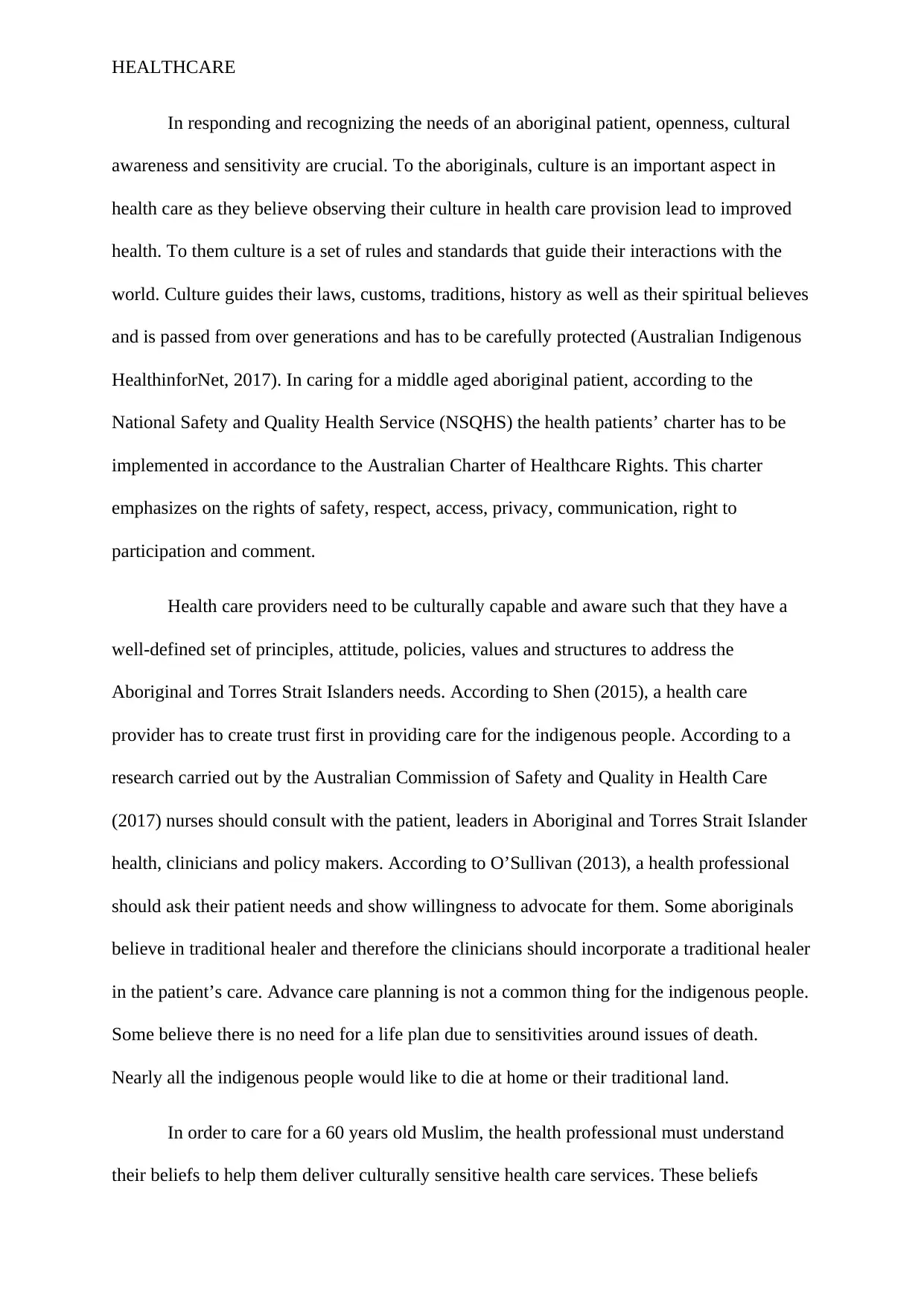
HEALTHCARE
In responding and recognizing the needs of an aboriginal patient, openness, cultural
awareness and sensitivity are crucial. To the aboriginals, culture is an important aspect in
health care as they believe observing their culture in health care provision lead to improved
health. To them culture is a set of rules and standards that guide their interactions with the
world. Culture guides their laws, customs, traditions, history as well as their spiritual believes
and is passed from over generations and has to be carefully protected (Australian Indigenous
HealthinforNet, 2017). In caring for a middle aged aboriginal patient, according to the
National Safety and Quality Health Service (NSQHS) the health patients’ charter has to be
implemented in accordance to the Australian Charter of Healthcare Rights. This charter
emphasizes on the rights of safety, respect, access, privacy, communication, right to
participation and comment.
Health care providers need to be culturally capable and aware such that they have a
well-defined set of principles, attitude, policies, values and structures to address the
Aboriginal and Torres Strait Islanders needs. According to Shen (2015), a health care
provider has to create trust first in providing care for the indigenous people. According to a
research carried out by the Australian Commission of Safety and Quality in Health Care
(2017) nurses should consult with the patient, leaders in Aboriginal and Torres Strait Islander
health, clinicians and policy makers. According to O’Sullivan (2013), a health professional
should ask their patient needs and show willingness to advocate for them. Some aboriginals
believe in traditional healer and therefore the clinicians should incorporate a traditional healer
in the patient’s care. Advance care planning is not a common thing for the indigenous people.
Some believe there is no need for a life plan due to sensitivities around issues of death.
Nearly all the indigenous people would like to die at home or their traditional land.
In order to care for a 60 years old Muslim, the health professional must understand
their beliefs to help them deliver culturally sensitive health care services. These beliefs
In responding and recognizing the needs of an aboriginal patient, openness, cultural
awareness and sensitivity are crucial. To the aboriginals, culture is an important aspect in
health care as they believe observing their culture in health care provision lead to improved
health. To them culture is a set of rules and standards that guide their interactions with the
world. Culture guides their laws, customs, traditions, history as well as their spiritual believes
and is passed from over generations and has to be carefully protected (Australian Indigenous
HealthinforNet, 2017). In caring for a middle aged aboriginal patient, according to the
National Safety and Quality Health Service (NSQHS) the health patients’ charter has to be
implemented in accordance to the Australian Charter of Healthcare Rights. This charter
emphasizes on the rights of safety, respect, access, privacy, communication, right to
participation and comment.
Health care providers need to be culturally capable and aware such that they have a
well-defined set of principles, attitude, policies, values and structures to address the
Aboriginal and Torres Strait Islanders needs. According to Shen (2015), a health care
provider has to create trust first in providing care for the indigenous people. According to a
research carried out by the Australian Commission of Safety and Quality in Health Care
(2017) nurses should consult with the patient, leaders in Aboriginal and Torres Strait Islander
health, clinicians and policy makers. According to O’Sullivan (2013), a health professional
should ask their patient needs and show willingness to advocate for them. Some aboriginals
believe in traditional healer and therefore the clinicians should incorporate a traditional healer
in the patient’s care. Advance care planning is not a common thing for the indigenous people.
Some believe there is no need for a life plan due to sensitivities around issues of death.
Nearly all the indigenous people would like to die at home or their traditional land.
In order to care for a 60 years old Muslim, the health professional must understand
their beliefs to help them deliver culturally sensitive health care services. These beliefs
⊘ This is a preview!⊘
Do you want full access?
Subscribe today to unlock all pages.

Trusted by 1+ million students worldwide
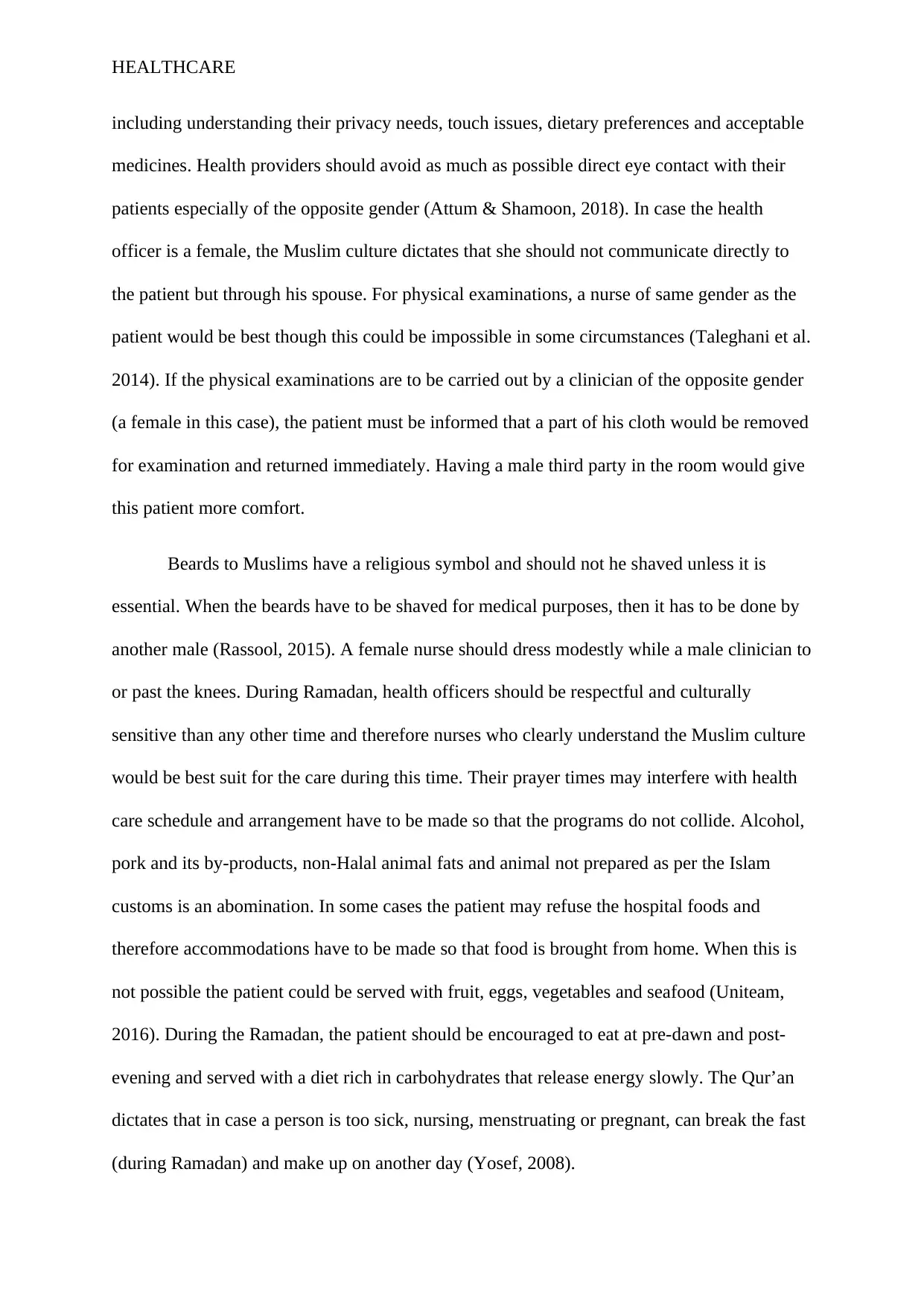
HEALTHCARE
including understanding their privacy needs, touch issues, dietary preferences and acceptable
medicines. Health providers should avoid as much as possible direct eye contact with their
patients especially of the opposite gender (Attum & Shamoon, 2018). In case the health
officer is a female, the Muslim culture dictates that she should not communicate directly to
the patient but through his spouse. For physical examinations, a nurse of same gender as the
patient would be best though this could be impossible in some circumstances (Taleghani et al.
2014). If the physical examinations are to be carried out by a clinician of the opposite gender
(a female in this case), the patient must be informed that a part of his cloth would be removed
for examination and returned immediately. Having a male third party in the room would give
this patient more comfort.
Beards to Muslims have a religious symbol and should not he shaved unless it is
essential. When the beards have to be shaved for medical purposes, then it has to be done by
another male (Rassool, 2015). A female nurse should dress modestly while a male clinician to
or past the knees. During Ramadan, health officers should be respectful and culturally
sensitive than any other time and therefore nurses who clearly understand the Muslim culture
would be best suit for the care during this time. Their prayer times may interfere with health
care schedule and arrangement have to be made so that the programs do not collide. Alcohol,
pork and its by-products, non-Halal animal fats and animal not prepared as per the Islam
customs is an abomination. In some cases the patient may refuse the hospital foods and
therefore accommodations have to be made so that food is brought from home. When this is
not possible the patient could be served with fruit, eggs, vegetables and seafood (Uniteam,
2016). During the Ramadan, the patient should be encouraged to eat at pre-dawn and post-
evening and served with a diet rich in carbohydrates that release energy slowly. The Qur’an
dictates that in case a person is too sick, nursing, menstruating or pregnant, can break the fast
(during Ramadan) and make up on another day (Yosef, 2008).
including understanding their privacy needs, touch issues, dietary preferences and acceptable
medicines. Health providers should avoid as much as possible direct eye contact with their
patients especially of the opposite gender (Attum & Shamoon, 2018). In case the health
officer is a female, the Muslim culture dictates that she should not communicate directly to
the patient but through his spouse. For physical examinations, a nurse of same gender as the
patient would be best though this could be impossible in some circumstances (Taleghani et al.
2014). If the physical examinations are to be carried out by a clinician of the opposite gender
(a female in this case), the patient must be informed that a part of his cloth would be removed
for examination and returned immediately. Having a male third party in the room would give
this patient more comfort.
Beards to Muslims have a religious symbol and should not he shaved unless it is
essential. When the beards have to be shaved for medical purposes, then it has to be done by
another male (Rassool, 2015). A female nurse should dress modestly while a male clinician to
or past the knees. During Ramadan, health officers should be respectful and culturally
sensitive than any other time and therefore nurses who clearly understand the Muslim culture
would be best suit for the care during this time. Their prayer times may interfere with health
care schedule and arrangement have to be made so that the programs do not collide. Alcohol,
pork and its by-products, non-Halal animal fats and animal not prepared as per the Islam
customs is an abomination. In some cases the patient may refuse the hospital foods and
therefore accommodations have to be made so that food is brought from home. When this is
not possible the patient could be served with fruit, eggs, vegetables and seafood (Uniteam,
2016). During the Ramadan, the patient should be encouraged to eat at pre-dawn and post-
evening and served with a diet rich in carbohydrates that release energy slowly. The Qur’an
dictates that in case a person is too sick, nursing, menstruating or pregnant, can break the fast
(during Ramadan) and make up on another day (Yosef, 2008).
Paraphrase This Document
Need a fresh take? Get an instant paraphrase of this document with our AI Paraphraser
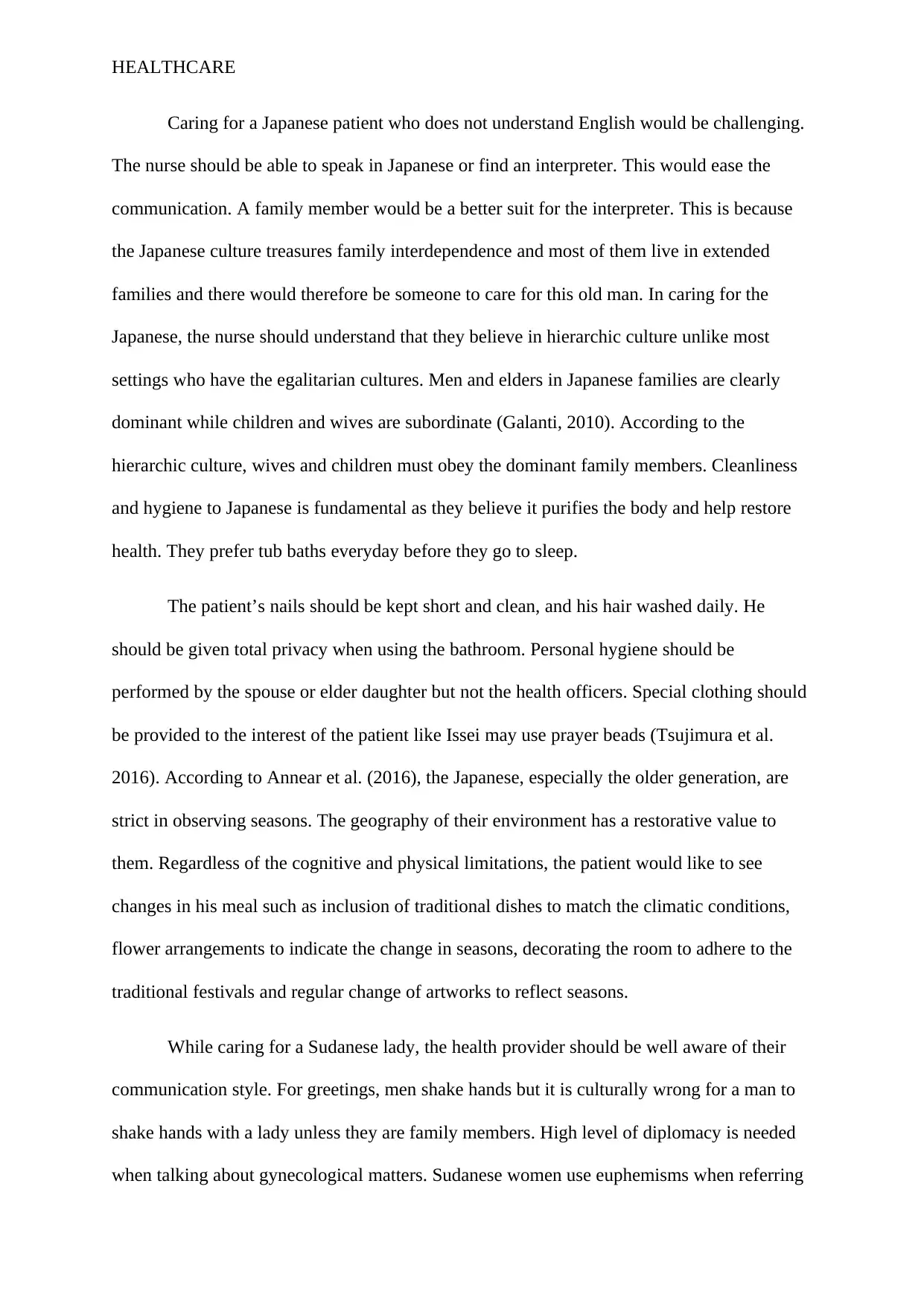
HEALTHCARE
Caring for a Japanese patient who does not understand English would be challenging.
The nurse should be able to speak in Japanese or find an interpreter. This would ease the
communication. A family member would be a better suit for the interpreter. This is because
the Japanese culture treasures family interdependence and most of them live in extended
families and there would therefore be someone to care for this old man. In caring for the
Japanese, the nurse should understand that they believe in hierarchic culture unlike most
settings who have the egalitarian cultures. Men and elders in Japanese families are clearly
dominant while children and wives are subordinate (Galanti, 2010). According to the
hierarchic culture, wives and children must obey the dominant family members. Cleanliness
and hygiene to Japanese is fundamental as they believe it purifies the body and help restore
health. They prefer tub baths everyday before they go to sleep.
The patient’s nails should be kept short and clean, and his hair washed daily. He
should be given total privacy when using the bathroom. Personal hygiene should be
performed by the spouse or elder daughter but not the health officers. Special clothing should
be provided to the interest of the patient like Issei may use prayer beads (Tsujimura et al.
2016). According to Annear et al. (2016), the Japanese, especially the older generation, are
strict in observing seasons. The geography of their environment has a restorative value to
them. Regardless of the cognitive and physical limitations, the patient would like to see
changes in his meal such as inclusion of traditional dishes to match the climatic conditions,
flower arrangements to indicate the change in seasons, decorating the room to adhere to the
traditional festivals and regular change of artworks to reflect seasons.
While caring for a Sudanese lady, the health provider should be well aware of their
communication style. For greetings, men shake hands but it is culturally wrong for a man to
shake hands with a lady unless they are family members. High level of diplomacy is needed
when talking about gynecological matters. Sudanese women use euphemisms when referring
Caring for a Japanese patient who does not understand English would be challenging.
The nurse should be able to speak in Japanese or find an interpreter. This would ease the
communication. A family member would be a better suit for the interpreter. This is because
the Japanese culture treasures family interdependence and most of them live in extended
families and there would therefore be someone to care for this old man. In caring for the
Japanese, the nurse should understand that they believe in hierarchic culture unlike most
settings who have the egalitarian cultures. Men and elders in Japanese families are clearly
dominant while children and wives are subordinate (Galanti, 2010). According to the
hierarchic culture, wives and children must obey the dominant family members. Cleanliness
and hygiene to Japanese is fundamental as they believe it purifies the body and help restore
health. They prefer tub baths everyday before they go to sleep.
The patient’s nails should be kept short and clean, and his hair washed daily. He
should be given total privacy when using the bathroom. Personal hygiene should be
performed by the spouse or elder daughter but not the health officers. Special clothing should
be provided to the interest of the patient like Issei may use prayer beads (Tsujimura et al.
2016). According to Annear et al. (2016), the Japanese, especially the older generation, are
strict in observing seasons. The geography of their environment has a restorative value to
them. Regardless of the cognitive and physical limitations, the patient would like to see
changes in his meal such as inclusion of traditional dishes to match the climatic conditions,
flower arrangements to indicate the change in seasons, decorating the room to adhere to the
traditional festivals and regular change of artworks to reflect seasons.
While caring for a Sudanese lady, the health provider should be well aware of their
communication style. For greetings, men shake hands but it is culturally wrong for a man to
shake hands with a lady unless they are family members. High level of diplomacy is needed
when talking about gynecological matters. Sudanese women use euphemisms when referring
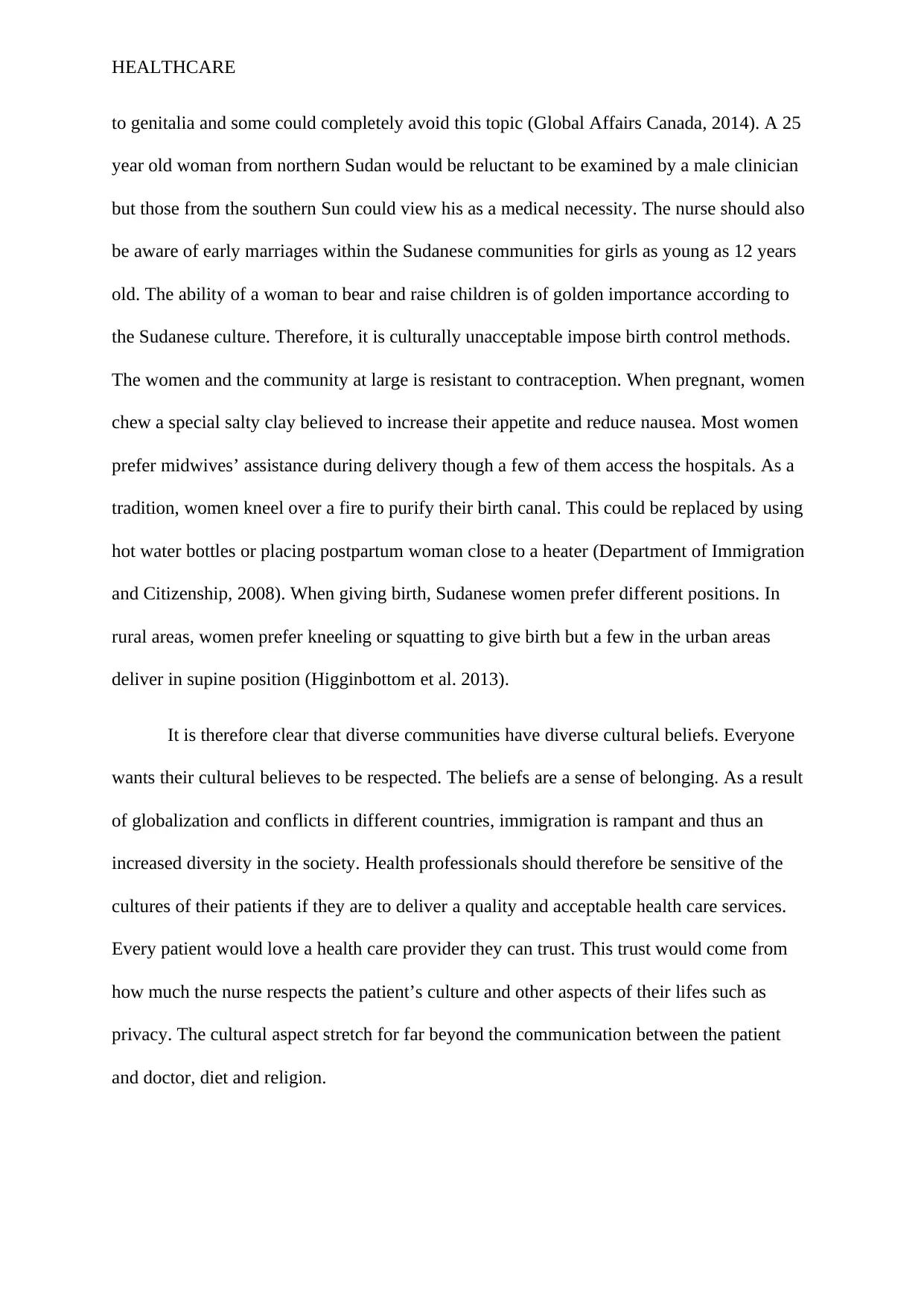
HEALTHCARE
to genitalia and some could completely avoid this topic (Global Affairs Canada, 2014). A 25
year old woman from northern Sudan would be reluctant to be examined by a male clinician
but those from the southern Sun could view his as a medical necessity. The nurse should also
be aware of early marriages within the Sudanese communities for girls as young as 12 years
old. The ability of a woman to bear and raise children is of golden importance according to
the Sudanese culture. Therefore, it is culturally unacceptable impose birth control methods.
The women and the community at large is resistant to contraception. When pregnant, women
chew a special salty clay believed to increase their appetite and reduce nausea. Most women
prefer midwives’ assistance during delivery though a few of them access the hospitals. As a
tradition, women kneel over a fire to purify their birth canal. This could be replaced by using
hot water bottles or placing postpartum woman close to a heater (Department of Immigration
and Citizenship, 2008). When giving birth, Sudanese women prefer different positions. In
rural areas, women prefer kneeling or squatting to give birth but a few in the urban areas
deliver in supine position (Higginbottom et al. 2013).
It is therefore clear that diverse communities have diverse cultural beliefs. Everyone
wants their cultural believes to be respected. The beliefs are a sense of belonging. As a result
of globalization and conflicts in different countries, immigration is rampant and thus an
increased diversity in the society. Health professionals should therefore be sensitive of the
cultures of their patients if they are to deliver a quality and acceptable health care services.
Every patient would love a health care provider they can trust. This trust would come from
how much the nurse respects the patient’s culture and other aspects of their lifes such as
privacy. The cultural aspect stretch for far beyond the communication between the patient
and doctor, diet and religion.
to genitalia and some could completely avoid this topic (Global Affairs Canada, 2014). A 25
year old woman from northern Sudan would be reluctant to be examined by a male clinician
but those from the southern Sun could view his as a medical necessity. The nurse should also
be aware of early marriages within the Sudanese communities for girls as young as 12 years
old. The ability of a woman to bear and raise children is of golden importance according to
the Sudanese culture. Therefore, it is culturally unacceptable impose birth control methods.
The women and the community at large is resistant to contraception. When pregnant, women
chew a special salty clay believed to increase their appetite and reduce nausea. Most women
prefer midwives’ assistance during delivery though a few of them access the hospitals. As a
tradition, women kneel over a fire to purify their birth canal. This could be replaced by using
hot water bottles or placing postpartum woman close to a heater (Department of Immigration
and Citizenship, 2008). When giving birth, Sudanese women prefer different positions. In
rural areas, women prefer kneeling or squatting to give birth but a few in the urban areas
deliver in supine position (Higginbottom et al. 2013).
It is therefore clear that diverse communities have diverse cultural beliefs. Everyone
wants their cultural believes to be respected. The beliefs are a sense of belonging. As a result
of globalization and conflicts in different countries, immigration is rampant and thus an
increased diversity in the society. Health professionals should therefore be sensitive of the
cultures of their patients if they are to deliver a quality and acceptable health care services.
Every patient would love a health care provider they can trust. This trust would come from
how much the nurse respects the patient’s culture and other aspects of their lifes such as
privacy. The cultural aspect stretch for far beyond the communication between the patient
and doctor, diet and religion.
⊘ This is a preview!⊘
Do you want full access?
Subscribe today to unlock all pages.

Trusted by 1+ million students worldwide
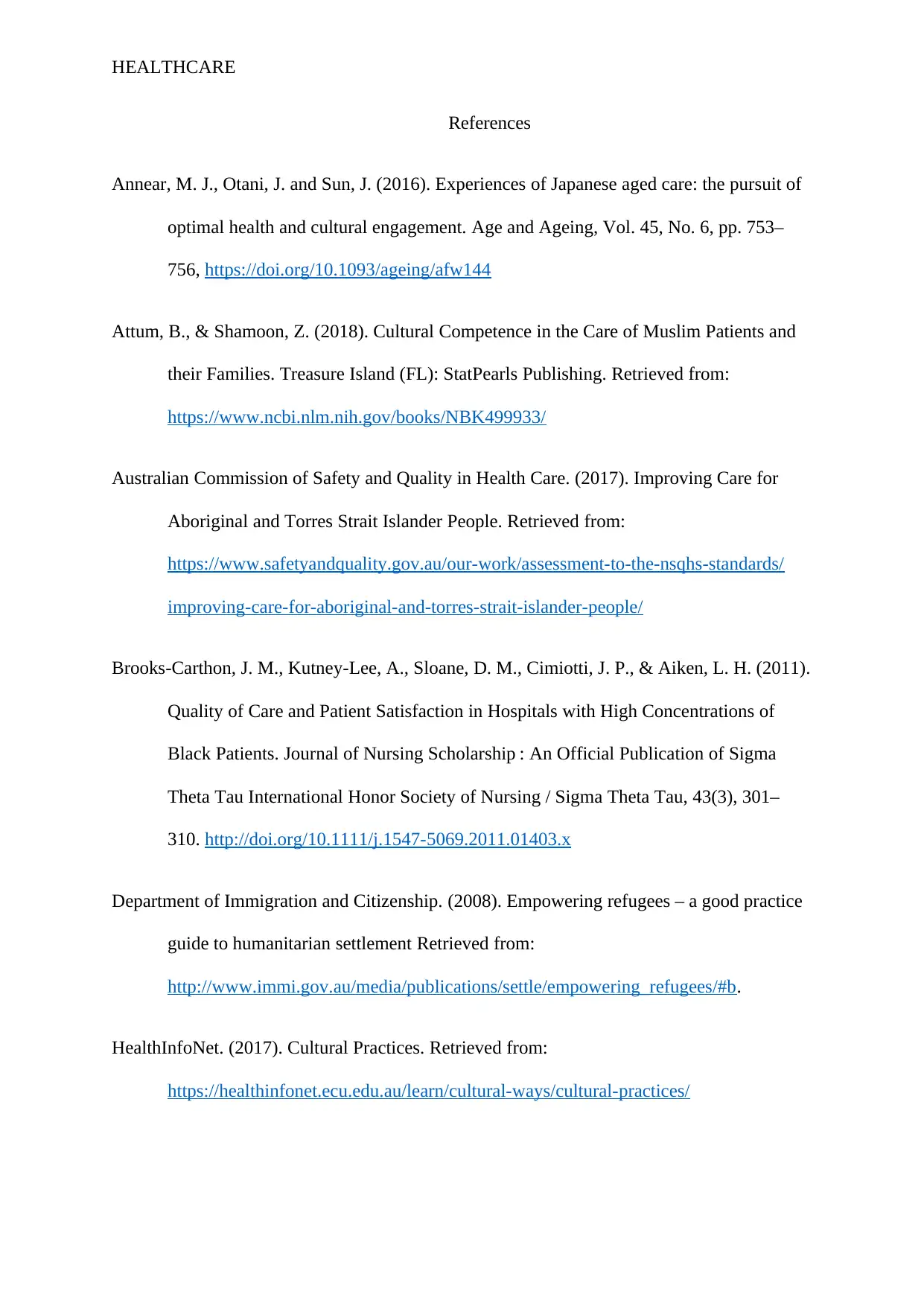
HEALTHCARE
References
Annear, M. J., Otani, J. and Sun, J. (2016). Experiences of Japanese aged care: the pursuit of
optimal health and cultural engagement. Age and Ageing, Vol. 45, No. 6, pp. 753–
756, https://doi.org/10.1093/ageing/afw144
Attum, B., & Shamoon, Z. (2018). Cultural Competence in the Care of Muslim Patients and
their Families. Treasure Island (FL): StatPearls Publishing. Retrieved from:
https://www.ncbi.nlm.nih.gov/books/NBK499933/
Australian Commission of Safety and Quality in Health Care. (2017). Improving Care for
Aboriginal and Torres Strait Islander People. Retrieved from:
https://www.safetyandquality.gov.au/our-work/assessment-to-the-nsqhs-standards/
improving-care-for-aboriginal-and-torres-strait-islander-people/
Brooks-Carthon, J. M., Kutney-Lee, A., Sloane, D. M., Cimiotti, J. P., & Aiken, L. H. (2011).
Quality of Care and Patient Satisfaction in Hospitals with High Concentrations of
Black Patients. Journal of Nursing Scholarship : An Official Publication of Sigma
Theta Tau International Honor Society of Nursing / Sigma Theta Tau, 43(3), 301–
310. http://doi.org/10.1111/j.1547-5069.2011.01403.x
Department of Immigration and Citizenship. (2008). Empowering refugees – a good practice
guide to humanitarian settlement Retrieved from:
http://www.immi.gov.au/media/publications/settle/empowering_refugees/#b.
HealthInfoNet. (2017). Cultural Practices. Retrieved from:
https://healthinfonet.ecu.edu.au/learn/cultural-ways/cultural-practices/
References
Annear, M. J., Otani, J. and Sun, J. (2016). Experiences of Japanese aged care: the pursuit of
optimal health and cultural engagement. Age and Ageing, Vol. 45, No. 6, pp. 753–
756, https://doi.org/10.1093/ageing/afw144
Attum, B., & Shamoon, Z. (2018). Cultural Competence in the Care of Muslim Patients and
their Families. Treasure Island (FL): StatPearls Publishing. Retrieved from:
https://www.ncbi.nlm.nih.gov/books/NBK499933/
Australian Commission of Safety and Quality in Health Care. (2017). Improving Care for
Aboriginal and Torres Strait Islander People. Retrieved from:
https://www.safetyandquality.gov.au/our-work/assessment-to-the-nsqhs-standards/
improving-care-for-aboriginal-and-torres-strait-islander-people/
Brooks-Carthon, J. M., Kutney-Lee, A., Sloane, D. M., Cimiotti, J. P., & Aiken, L. H. (2011).
Quality of Care and Patient Satisfaction in Hospitals with High Concentrations of
Black Patients. Journal of Nursing Scholarship : An Official Publication of Sigma
Theta Tau International Honor Society of Nursing / Sigma Theta Tau, 43(3), 301–
310. http://doi.org/10.1111/j.1547-5069.2011.01403.x
Department of Immigration and Citizenship. (2008). Empowering refugees – a good practice
guide to humanitarian settlement Retrieved from:
http://www.immi.gov.au/media/publications/settle/empowering_refugees/#b.
HealthInfoNet. (2017). Cultural Practices. Retrieved from:
https://healthinfonet.ecu.edu.au/learn/cultural-ways/cultural-practices/
Paraphrase This Document
Need a fresh take? Get an instant paraphrase of this document with our AI Paraphraser
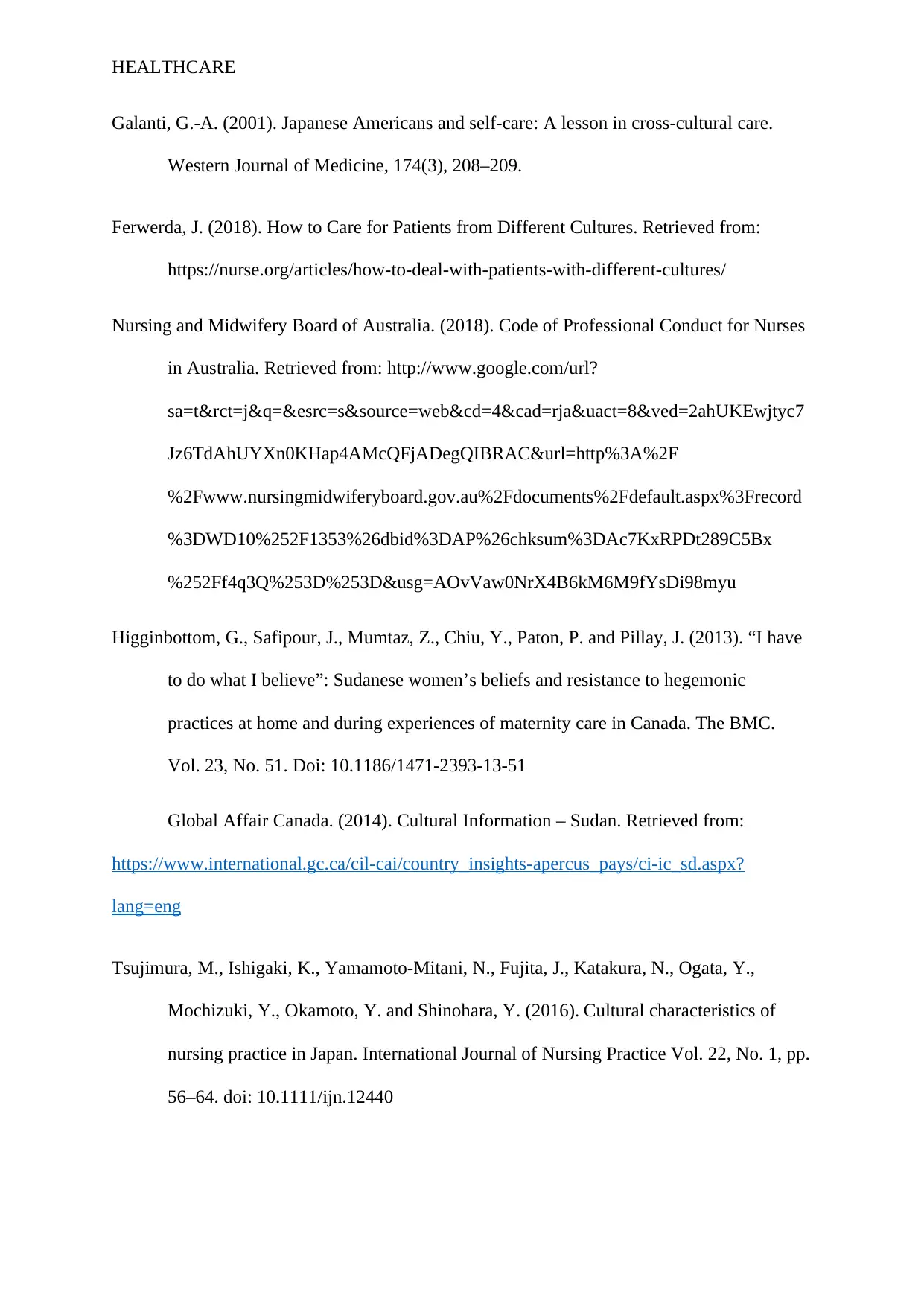
HEALTHCARE
Galanti, G.-A. (2001). Japanese Americans and self-care: A lesson in cross-cultural care.
Western Journal of Medicine, 174(3), 208–209.
Ferwerda, J. (2018). How to Care for Patients from Different Cultures. Retrieved from:
https://nurse.org/articles/how-to-deal-with-patients-with-different-cultures/
Nursing and Midwifery Board of Australia. (2018). Code of Professional Conduct for Nurses
in Australia. Retrieved from: http://www.google.com/url?
sa=t&rct=j&q=&esrc=s&source=web&cd=4&cad=rja&uact=8&ved=2ahUKEwjtyc7
Jz6TdAhUYXn0KHap4AMcQFjADegQIBRAC&url=http%3A%2F
%2Fwww.nursingmidwiferyboard.gov.au%2Fdocuments%2Fdefault.aspx%3Frecord
%3DWD10%252F1353%26dbid%3DAP%26chksum%3DAc7KxRPDt289C5Bx
%252Ff4q3Q%253D%253D&usg=AOvVaw0NrX4B6kM6M9fYsDi98myu
Higginbottom, G., Safipour, J., Mumtaz, Z., Chiu, Y., Paton, P. and Pillay, J. (2013). “I have
to do what I believe”: Sudanese women’s beliefs and resistance to hegemonic
practices at home and during experiences of maternity care in Canada. The BMC.
Vol. 23, No. 51. Doi: 10.1186/1471-2393-13-51
Global Affair Canada. (2014). Cultural Information – Sudan. Retrieved from:
https://www.international.gc.ca/cil-cai/country_insights-apercus_pays/ci-ic_sd.aspx?
lang=eng
Tsujimura, M., Ishigaki, K., Yamamoto-Mitani, N., Fujita, J., Katakura, N., Ogata, Y.,
Mochizuki, Y., Okamoto, Y. and Shinohara, Y. (2016). Cultural characteristics of
nursing practice in Japan. International Journal of Nursing Practice Vol. 22, No. 1, pp.
56–64. doi: 10.1111/ijn.12440
Galanti, G.-A. (2001). Japanese Americans and self-care: A lesson in cross-cultural care.
Western Journal of Medicine, 174(3), 208–209.
Ferwerda, J. (2018). How to Care for Patients from Different Cultures. Retrieved from:
https://nurse.org/articles/how-to-deal-with-patients-with-different-cultures/
Nursing and Midwifery Board of Australia. (2018). Code of Professional Conduct for Nurses
in Australia. Retrieved from: http://www.google.com/url?
sa=t&rct=j&q=&esrc=s&source=web&cd=4&cad=rja&uact=8&ved=2ahUKEwjtyc7
Jz6TdAhUYXn0KHap4AMcQFjADegQIBRAC&url=http%3A%2F
%2Fwww.nursingmidwiferyboard.gov.au%2Fdocuments%2Fdefault.aspx%3Frecord
%3DWD10%252F1353%26dbid%3DAP%26chksum%3DAc7KxRPDt289C5Bx
%252Ff4q3Q%253D%253D&usg=AOvVaw0NrX4B6kM6M9fYsDi98myu
Higginbottom, G., Safipour, J., Mumtaz, Z., Chiu, Y., Paton, P. and Pillay, J. (2013). “I have
to do what I believe”: Sudanese women’s beliefs and resistance to hegemonic
practices at home and during experiences of maternity care in Canada. The BMC.
Vol. 23, No. 51. Doi: 10.1186/1471-2393-13-51
Global Affair Canada. (2014). Cultural Information – Sudan. Retrieved from:
https://www.international.gc.ca/cil-cai/country_insights-apercus_pays/ci-ic_sd.aspx?
lang=eng
Tsujimura, M., Ishigaki, K., Yamamoto-Mitani, N., Fujita, J., Katakura, N., Ogata, Y.,
Mochizuki, Y., Okamoto, Y. and Shinohara, Y. (2016). Cultural characteristics of
nursing practice in Japan. International Journal of Nursing Practice Vol. 22, No. 1, pp.
56–64. doi: 10.1111/ijn.12440
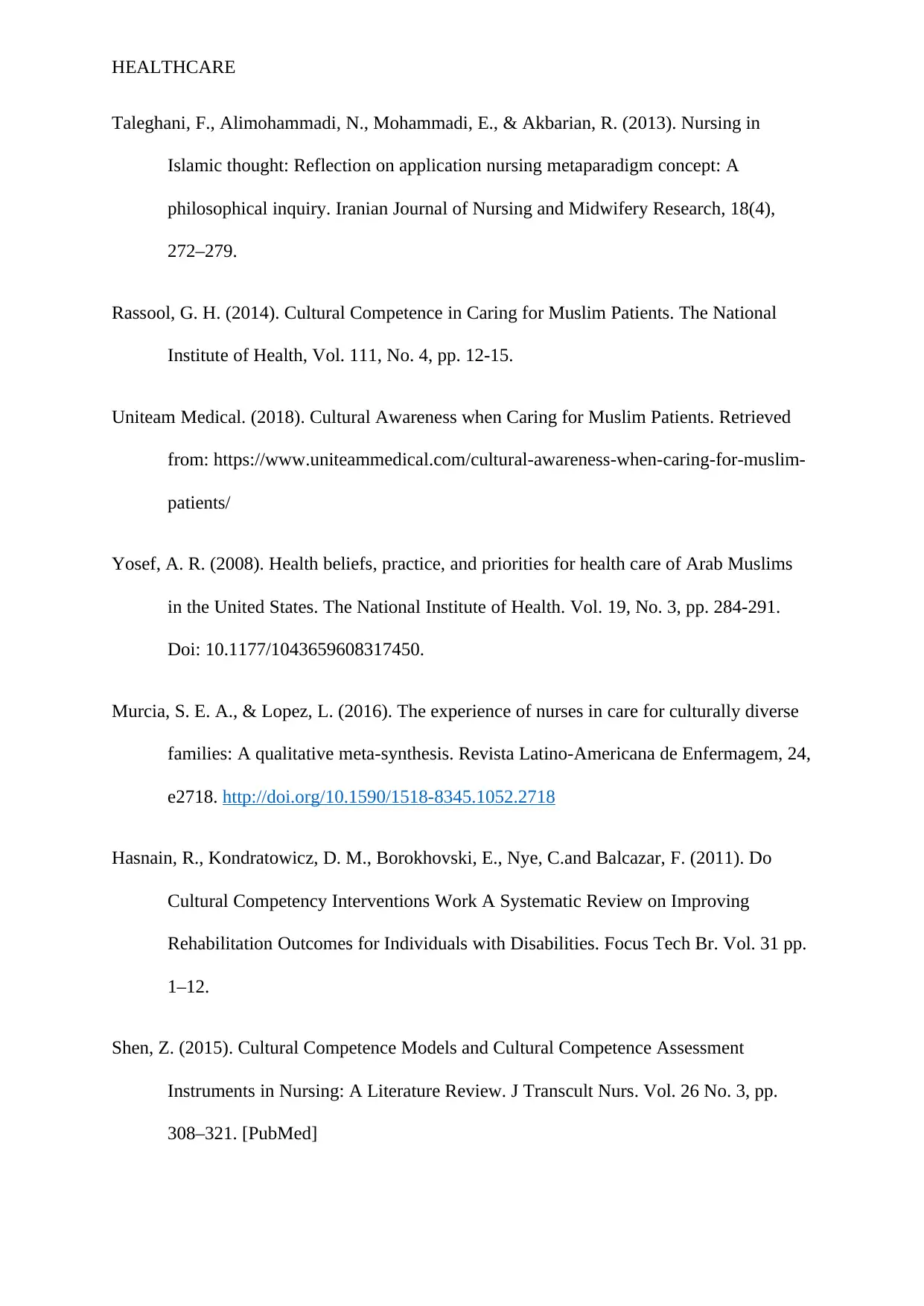
HEALTHCARE
Taleghani, F., Alimohammadi, N., Mohammadi, E., & Akbarian, R. (2013). Nursing in
Islamic thought: Reflection on application nursing metaparadigm concept: A
philosophical inquiry. Iranian Journal of Nursing and Midwifery Research, 18(4),
272–279.
Rassool, G. H. (2014). Cultural Competence in Caring for Muslim Patients. The National
Institute of Health, Vol. 111, No. 4, pp. 12-15.
Uniteam Medical. (2018). Cultural Awareness when Caring for Muslim Patients. Retrieved
from: https://www.uniteammedical.com/cultural-awareness-when-caring-for-muslim-
patients/
Yosef, A. R. (2008). Health beliefs, practice, and priorities for health care of Arab Muslims
in the United States. The National Institute of Health. Vol. 19, No. 3, pp. 284-291.
Doi: 10.1177/1043659608317450.
Murcia, S. E. A., & Lopez, L. (2016). The experience of nurses in care for culturally diverse
families: A qualitative meta-synthesis. Revista Latino-Americana de Enfermagem, 24,
e2718. http://doi.org/10.1590/1518-8345.1052.2718
Hasnain, R., Kondratowicz, D. M., Borokhovski, E., Nye, C.and Balcazar, F. (2011). Do
Cultural Competency Interventions Work A Systematic Review on Improving
Rehabilitation Outcomes for Individuals with Disabilities. Focus Tech Br. Vol. 31 pp.
1–12.
Shen, Z. (2015). Cultural Competence Models and Cultural Competence Assessment
Instruments in Nursing: A Literature Review. J Transcult Nurs. Vol. 26 No. 3, pp.
308–321. [PubMed]
Taleghani, F., Alimohammadi, N., Mohammadi, E., & Akbarian, R. (2013). Nursing in
Islamic thought: Reflection on application nursing metaparadigm concept: A
philosophical inquiry. Iranian Journal of Nursing and Midwifery Research, 18(4),
272–279.
Rassool, G. H. (2014). Cultural Competence in Caring for Muslim Patients. The National
Institute of Health, Vol. 111, No. 4, pp. 12-15.
Uniteam Medical. (2018). Cultural Awareness when Caring for Muslim Patients. Retrieved
from: https://www.uniteammedical.com/cultural-awareness-when-caring-for-muslim-
patients/
Yosef, A. R. (2008). Health beliefs, practice, and priorities for health care of Arab Muslims
in the United States. The National Institute of Health. Vol. 19, No. 3, pp. 284-291.
Doi: 10.1177/1043659608317450.
Murcia, S. E. A., & Lopez, L. (2016). The experience of nurses in care for culturally diverse
families: A qualitative meta-synthesis. Revista Latino-Americana de Enfermagem, 24,
e2718. http://doi.org/10.1590/1518-8345.1052.2718
Hasnain, R., Kondratowicz, D. M., Borokhovski, E., Nye, C.and Balcazar, F. (2011). Do
Cultural Competency Interventions Work A Systematic Review on Improving
Rehabilitation Outcomes for Individuals with Disabilities. Focus Tech Br. Vol. 31 pp.
1–12.
Shen, Z. (2015). Cultural Competence Models and Cultural Competence Assessment
Instruments in Nursing: A Literature Review. J Transcult Nurs. Vol. 26 No. 3, pp.
308–321. [PubMed]
⊘ This is a preview!⊘
Do you want full access?
Subscribe today to unlock all pages.

Trusted by 1+ million students worldwide
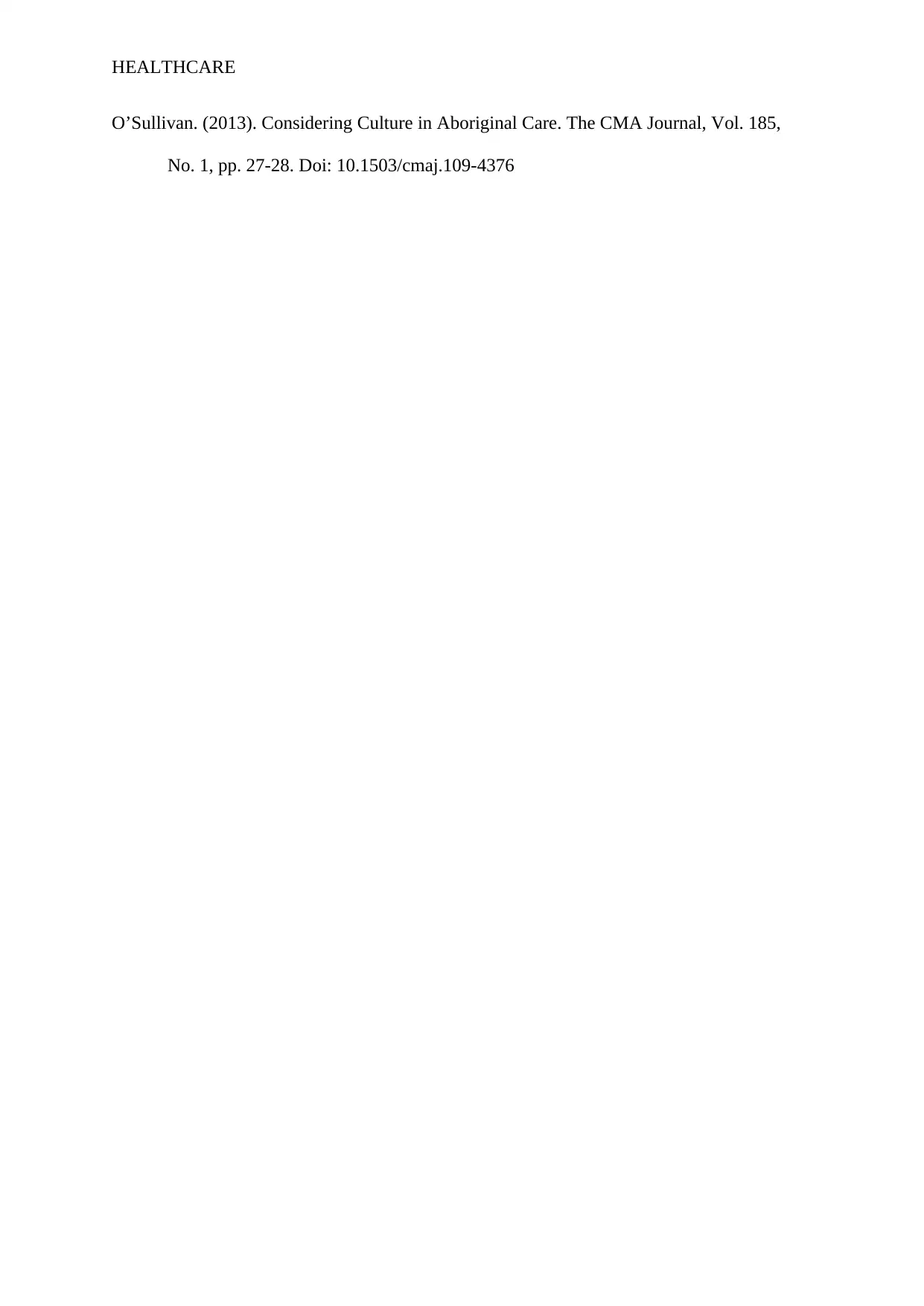
HEALTHCARE
O’Sullivan. (2013). Considering Culture in Aboriginal Care. The CMA Journal, Vol. 185,
No. 1, pp. 27-28. Doi: 10.1503/cmaj.109-4376
O’Sullivan. (2013). Considering Culture in Aboriginal Care. The CMA Journal, Vol. 185,
No. 1, pp. 27-28. Doi: 10.1503/cmaj.109-4376
1 out of 10
Related Documents
Your All-in-One AI-Powered Toolkit for Academic Success.
+13062052269
info@desklib.com
Available 24*7 on WhatsApp / Email
![[object Object]](/_next/static/media/star-bottom.7253800d.svg)
Unlock your academic potential
Copyright © 2020–2025 A2Z Services. All Rights Reserved. Developed and managed by ZUCOL.



